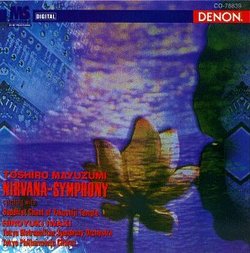| All Artists: Mayuzumi Title: Nirvana Symphony Members Wishing: 0 Total Copies: 0 Label: Denon Records Release Date: 8/1/1996 Genre: Classical Styles: Opera & Classical Vocal, Historical Periods, Early Music, Modern, 20th, & 21st Century, Symphonies Number of Discs: 1 SwapaCD Credits: 1 UPC: 081757883924 |
Search - Mayuzumi :: Nirvana Symphony
 | Mayuzumi Nirvana Symphony Genre: Classical
|
Larger Image |
CD Details |
CD ReviewsBuddhism and Carl Orff Discophage | France | 05/15/2008 (3 out of 5 stars) "Funny how knowing or NOT knowing what you are hearing might color your reception of it. I've recently heard and reviewed two CDs of music of Toshiro Mayuzumi (Toshiro Mayuzumi: Pieces for Prepared Piano and Strings / Samsara, Symphonic Poem / Essay for String Orchestra, Toshiro Mayuzumi: Samsara / Phonologie Symphonique / Bacchanale), whom I tend to view as the "other" Japanese 20th Century composer, one who remained in the shadow of Toru Takemitsu, neither as avant-garde nor as successful - and if the number of available recordings is a good pointer, I am being pretty fair in my view. Further (and it may be an element of explanation), I found the music enjoyable, but not particularly original, easy accessible 20th Century music harking back to Roussel, Stravinsky and, at its most advanced, Varèse; the two CDs were disappointingly short as well (they both run circa a paltry 40 minutes). Still, as there was so little Mayuzumi available on CD, I decided to go for it, and it appeared much cheaper to buy this disc directly in Japan than on this website's marketplace. Apparently it's been reissued by Denon on a budget series.
But I do NOT know what the Nirvana Symphony is about, as the notes are in Japanese only. From the rare information available on the net I've gathered that the Symphony is subtitled "A Buddhist Cantata", and it is also about bells, that's for sure : Movements 1, 3 and 5 are titled Campanology I, II and III and explore various bell sonorities. Campanology I develops a powerful and slow-moving pulse, like the flow and ebb of the sea, reminiscent of the atmospheric music of Ligeti, with whiffs of a sentimental solo violin which could be direct out of Ernest Bloch or Szymanowski. Campanology II has soft, hushed, mysterious, dream-like bells, very subtle and beautiful, and at times orchestral sonorities shimmering like the Awakening in Ravel's Daphnis, further developing in something terse and enigmatic, sounding very much like serial music. Campanology III is more pounding, in a way that would evoke Orff or Stravinsky's Les Noces. These three movements are separated by two movements of what seems an imitation or derivation of Buddhist psalmody, track two evolving after about 5 minutes and a half into a pounding orchestral pulse reminiscent of Stravinsky's Le Sacre, or more still (Chorus helping) of Orff's Carmina Burana. The powerful Finale with its wordless men's chorus reminded me of Britten's Billy Budd. That's how advanced, or not so advanced, Mayuzumi's vocabulary sounded to me. It is enjoyable, but it does not give the impression that you are hearing something you haven't heard before. The Symphony is circa 37:30 long and the disc is completed by 37:30 more minutes of Bhuddist chant - not the merriest or more varied kind of music. My advice then: unless you are an adept of Buddhism, find it cheap. " |

 Track Listings (16) - Disc #1
Track Listings (16) - Disc #1